What is an Exhaust Downpipe? What does a Downpipe do?

What is a downpipe?
The downpipe is the pipe that connects the turbocharger to the exhaust system. As such, it’s generally located between the turbo and the centre muffler. The downpipe can be used standalone or as part of a sport exhaust, in which case it replaces the exhaust pipe installed as standard. Since it has a larger diameter, a downpipe reduces exhaust back pressure, significantly enhancing performance – and driving thrills! – when combined with other tuning steps.
What parts does a downpipe consist of and what diameter should it have?
Depending on the model, downpipes consist of the connection flange for the turbocharger, a threaded connection for the lambda sensor, a flexible hose, plus a pre-cat and main cat. The flexible hose curbs vibrations and reduces stress on the exhaust system during acceleration. This stops the individual components of the exhaust system coming apart from each other and improves durability.
The catalytic converters keep emission values compliant. They filter pollutants out of the exhaust gases, and depending on their design and material, can also help reduce exhaust gas accumulation. If you’re itching to know more, check out the information on our sport cats.
The preferred material for downpipes is stainless steel, as it easily withstands high thermal stress. It’s also highly corrosion resistant.
As for the right diameter, it depends on your spec. A wider downpipe diameter always increases flow rate and therefore boosts performance and response.
What are the advantages of a downpipe?
Tuning the downpipe actually has a lot of advantages, mainly when you combine it with engine characteristics optimisation (chip tuning). This fine-tunes the software to match the hardware perfectly, giving you yet another significant boost in performance. As the downpipe has a larger diameter, it reduces stress on the turbo charger, which can blow more exhaust gas through a wider pipe because the back pressure is much lower than with the series part. It also helps cool the exhaust gases, which translates to a noticeable increase in torque. The rich sound of a downpipe is an unadulterated joy; if you’re into motorsport, it’ll blow you away. All things considered, a downpipe is a great performance-boosting option for any car with a turbocharger and a driver with sporty ambitions.
The advantages at a glance:
- Lower exhaust back pressure
- A richer, sportier sound
- Higher torque
- Improved turbo response
- Longer turbo service life
- More hp when combined with chip tuning
- Lower fuel consumption
DOWNPIPE BASICS
A downpipe directs the exhaust gases from your vehicle's turbine housing into your exhaust system. The downpipe bolts right to the turbine housing. It is instrumental in moving the exhaust gases through the system as efficiently as possible.
The average downpipe has at least one restrictive catalytic converter. These do an excellent job of cleaning exhaust gases as they are produced. The only issue is their restrictive aspect. They cause you to lose power, and likely part of the reason you’re buying a high-end car like a Mercedes is the power that comes with it.
Another aspect of the typical sports car exhaust system that you’ll likely notice is mandrel bending. This is where a steel rod is inserted into bent tubing, so there is no wrinkling or breaking at the bend point.
Should You Keep the Downpipe that Comes with Your Vehicle?
Let’s say you get yourself a high-end, supercharged vehicle, like a Mercedes. You’re probably serious about testing its limits when you drive it. If that’s true, you might look into purchasing an aftermarket downpipe replacement.
Mercedes exhausts that are standard-issue are already considered to be high-performance quality. However, you probably didn’t buy the Mercedes to be timid.
That’s why you might want to remove the original downpipe that came with your Mercedes and replace it with an aftermarket version larger in diameter. You also might remove the catalytic converter, or another way to go is to install a high-flowing converter.
WHY YOU NEED A DOWNPIPE
A downpipe is put in place because it allows the turbo aspect of the engine to be more effective. The downpipe steers gases away from the turbine, creating more uninterrupted power. When you get out on a straightaway and open up your Mercedes, or a similar vehicle, you’ll feel the difference.
Aftermarket downpipes usually feature wider capacities, and they are less restrictive than the stock option. This increase in diameter allows for greater space for a faster turbo spin.
The increased spin makes a huge difference. It decreases turbo lag and generates more spool. When you make this switch, you’re reducing intake charge and engine temperature. This will bring the increase in engine power you were craving.
A non-factory issue downpipe significantly increases enjoyment for many car owners who want to fully appreciate the vehicle’s power potential.
THE DIFFERENCE BETWEEN CAT VS. CATLESS
If you want to get yourself an aftermarket downpipe, you’re going to run into two kinds: cat and catless. Catted means that it comes with a high-flow catalytic converter. Catless downpipes come without one.
Catalytic converters clean exhaust gases as they pass through a catalyst. This deals with the smell from the raw exhaust fumes. If you get a catless version, then the vehicle will emit a noticeable odor. That’s because the exhaust gases aren’t being cleaned before the vehicle emits them.
You probably don’t want the smell that comes with a catless converter, which is why many sports car owners opt for the catless variety.
BUYING A NEW DOWNPIPE
If you aspire to race your sports car, that is one of the more common reasons for replacing the downpipe. You might choose to do so simply because you are trying to get as much horsepower as possible out of your vehicle. Adding a new downpipe to older model sports cars can dramatically improve your HP.
There is another potential reason. You might have modified your turbo so that it runs at a higher boost pressure. If you have increased the amount of boost from a stock turbo system, then the increased exhaust output might demand a smooth, larger downpipe.
Keep in mind that the standard downpipe for sports cars is typically of excellent quality. It’s entirely your prerogative whether you’re satisfied with your exhaust materials or want to modify them further to get that extra boost.
WHAT IS A DOWNPIPE?
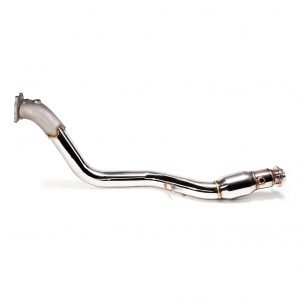
It’s important to understand what occurs prior to the downpipe in order to better understand how changes in the downpipe are beneficial. We’ll cover the wastegate which is a crucial component of a turbocharged vehicle. To get a refresher on what happens prior to the wastegate, check out “How Turbochargers Work“.
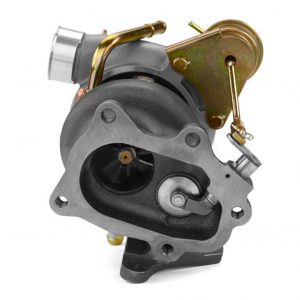
The wastegate can be internal (located inside the turbine housing next to the wheel (pictured above) or external (mounted on the header or somewhere before the turbine wheel and after the exhaust valve). Both accomplish the same function which is to bleed off excess gasses and slow the turbine wheel. This results in the slowing of the compressor wheel and prevents exceeding boost targets. This is done by actuating (opening) and allowing air through the wastegate instead of having it pass over the exhaust turbine wheel. It will then quickly close as to not bleed off too much air and cause a loss in compression in the intake tract (boost). The strategy used to control the wastegate can vary greatly between manufacturers. Now that we’ve covered the wastegate function, we can get to the exhaust downpipe.
The spent gasses travel out of the turbine housing outlet into the downpipe. Side note: this part of the exhaust is usually called a downpipe because, you guessed it, it’s a pipe that travels downward. As turbo configurations change, the name might also (the 2015+ WRX has a low, front-mounted turbo, where a “J-pipe” is the first part of the exhaust connected to the turbine housing outlet). Whatever you call it, a downpipe is the first portion of the exhaust post turbo and is typically the most restricted portion on factory turbocharged vehicles. Upgrading this component, paired with proper tuning, is typically the best bang for your buck modification (although it does vary for platform).
TYPES OF DOWNPIPES
From the above, we know the purpose of an upgraded downpipe is to increase performance by allowing increased flow. Turbulence is one main factor. If the gasses are all stagnating and/or running into protrusions or running into each other, it creates more backpressure than a well designed system. The more laminar (smooth and straight) the gasses flow, the more the system can flow for a given pipe diameter. Steep angles and abrupt pipe diameter changes should be avoided.
Some of the common downpipe designs include: flanges with a simple pipe, bell mouths, divorced wastegate, and split bell mouths. You also have castings and formed piping to choose from. Which one works best is also determined by quite a few different factors and how well they are designed and manufactured.
FLANGE WITH SIMPLE PIPE
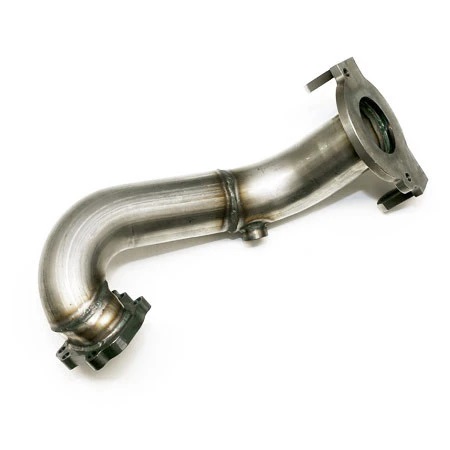
The only advantages to this design are cost and simplicity. The pipe does not have to be formed and the flange is simple therefore reducing cost. The labor to weld the pipe to the flange is easy and therefore less costly as well. That is the main factor that makes it desirable to the factory and why it is used on many stock exhausts. The wastegate gasses joining the turbo gasses right at the turbo outlet does create turbulence in the worst spot post turbo and reduces flow, thus not making it as desirable for performance as other designs.
BELLMOUTH
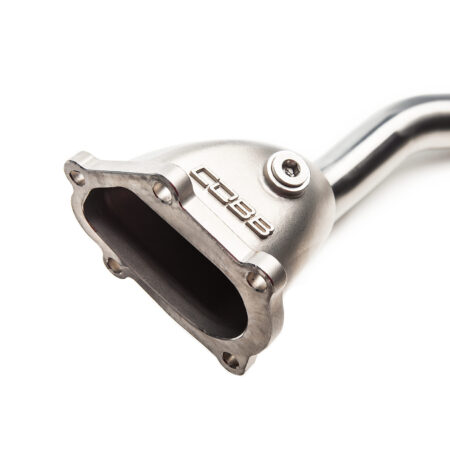
This method is much closer to optimal for joining the gasses from the outlets. There is more room for them to join and if the transition is done properly it can flow very well into the main piping. It packages very well and does not have a lot of complexity, making for fewer points of failure. We have gotten the best results from this type of downpipe so far. Boost response has been the best out of the outlet designs we have tuned on and it is easy to put a wideband oxygen sensor bung into. We have also had the fewest problems with this design.
SPLIT BELLMOUTH
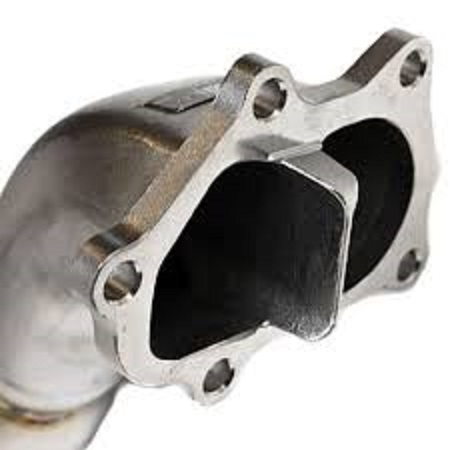
This design separates the gasses in the beginning of the turbo outlet and joins them at the rear of the bell mouth section. It works well and has some of the advantages of the bell mouth and some of the advantages of the divorced wastegate designs. The main deterrent for this is the cost and complexity of adding the splitter. For most of us, keeping things as simple as possible while still making the product work well is best.
DIVORCED WASTEGATE
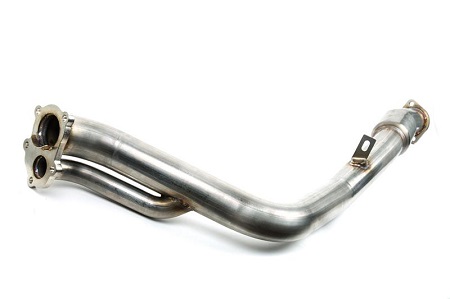
Keeping the gasses from the turbo outlet and wastegate separate until farther back in the system is an attempt to combine the advantages of not collecting the gasses and the real world. Combining them far back is closer to optimal than collecting them closer to the outlets. It is also critical to power production and spool-up to join the pipes smoothly and avoid turbulence. The disadvantages are that you add a lot of cost and complexity. You have big temperature differences on each pipe and that makes for a system that can crack. Putting in flex or expansion joints help, but adds even further complexity and yet another part to fail.
With all of the exhaust systems we have tuned with on the dyno, we have seen that it is generally harder to bring boost on as quickly with these types of systems as compared to the bell mouth type systems. Also, we have had a few situations where the splitter caused problems allowing the wastegate to function properly by not allowing it to open to its full extent, or even open at all. That caused either boost spiking or no control over boost.
Since the wastegate could not function the turbo ran as if it did even not have one, and the poor turbo just ran whatever boost it could make uncontrolled. The fix was not hard, but the least amount of stuff to go wrong the better. Noone would be happy having to pay for someone to install the exhaust only to have another place diagnose the problem, remove the exhaust, repair the part, and re-install the exhaust.
CAST OUTLETS
Castings have the advantage of keeping a lot of heat in the exhaust as well as freedom with design. You can basically make it almost any shape you want. The disadvantages are more weight and cost. Cast iron pieces can weigh a ton which is a valid concern with performance in mind. The casting form that the piece is made in is also very expensive and depending on complexity can range from a couple of thousand dollars to upwards of tens of thousands of dollars.
FORMED PIPING
Forming pipe has almost as much design freedom as a casting with less expense and less weight. The only disadvantage lies in if it is not done properly. Poor forming can look bad and affect flow by having creases and crimped spots. You can also get the piping too thin if you try to stretch the metal too far. If done improperly you can also make the metal brittle and it will usually happen where the metal is the thinnest.
Remember, you will only flow as well as the greatest restriction. If you have a poor cat or muffler design then it will choke the flow no matter how good the rest of the system is designed. Fortunately, straight-through mufflers and newer high flow cats flow very well. Having a cat is not only good for the environment, but we have seen very little power difference in levels in excess of over 350 horsepower. More on catalytic converters later.
Pipe diameter does have an effect on flow rates but is not the major factor in most cases. 2.5″ may flow enough for 300-350 horsepower without being a restriction. 3″ is usually capable of flowing 500-600 horsepower before becoming a restriction. This is assuming that you have designed the rest of the system up to par. There are also full 3.5″ systems and those that start out at 4″ and taper down. Unless you are making over 500-600 h.p. anything over 3″ is a case of diminishing returns and in most cases has no advantage.
Now that we’ve covered different designs of downpipes, we come to the most glaring difference; those with catalytic converters, or “cats”, and those without. These are also referred to as catted vs catless downpipes.


Leave a comment